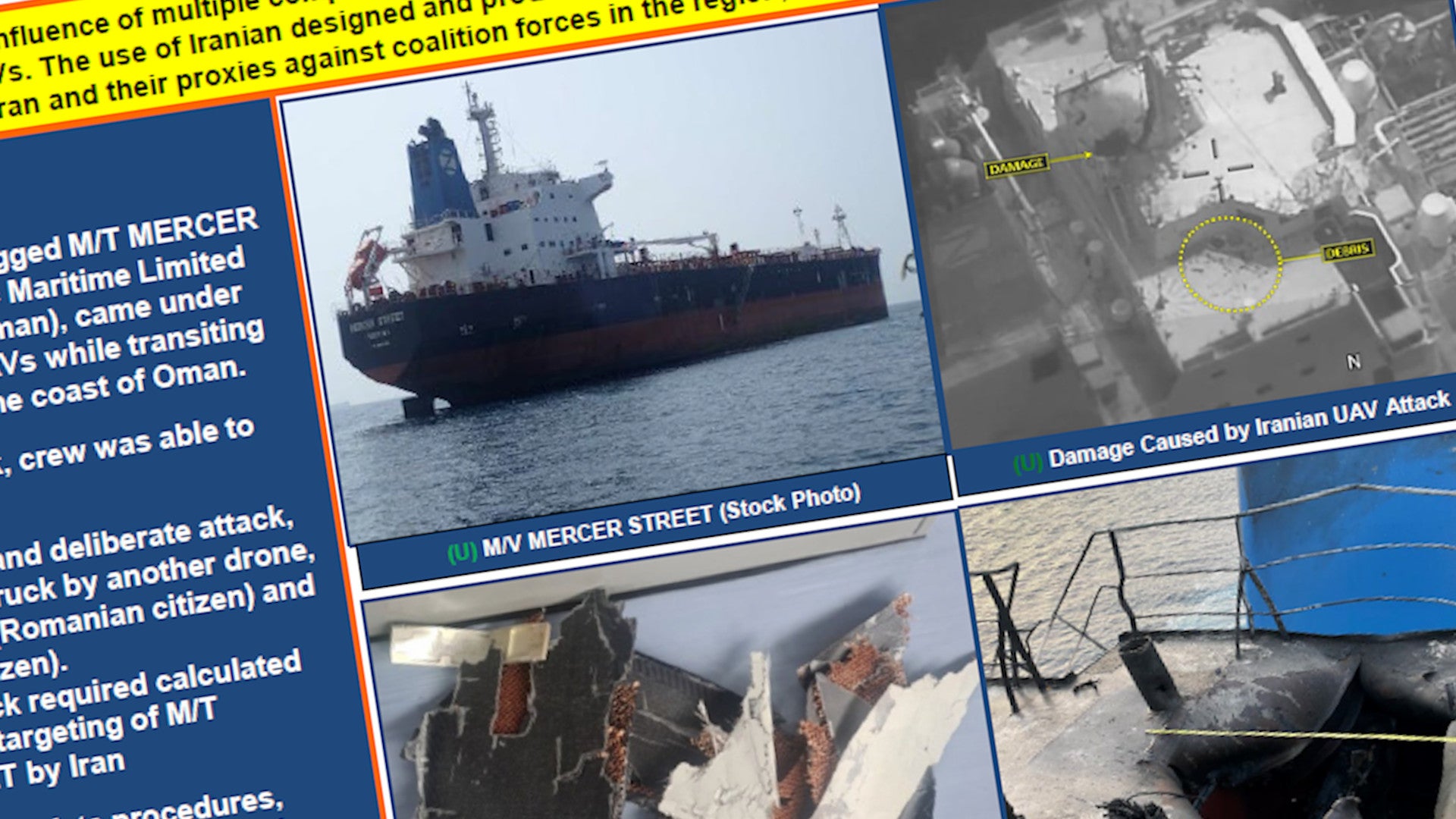U.S. Central Command has released details from its investigation into a fatal drone attack on the Liberian-flagged, Israeli-operated tanker M/T Mercer Street
off the coast of Oman last week. It says that debris and other evidence collected from that attack, as well as from two other previously undisclosed attacks on the ship that failed to cause any damage or casualties, shows that “Iran was actively involved.” The entire episode only further underscores the ever-increasing threat that small unmanned aircraft pose in this region, as well as elsewhere around the world, on and off the battlefield.
Mercer Street was unsuccessfully attacked twice on July 29, 2021, according to U.S. Central Command (CENTCOM). The third strike, which killed one British and one Romanian national onboard the ship, occurred on July 30. All three attacks were carried out using what the U.S. military is now increasingly referring to as “one-way attack unmanned aerial vehicles,” but which are also commonly referred to as “suicide drones” or “kamikaze drones.”
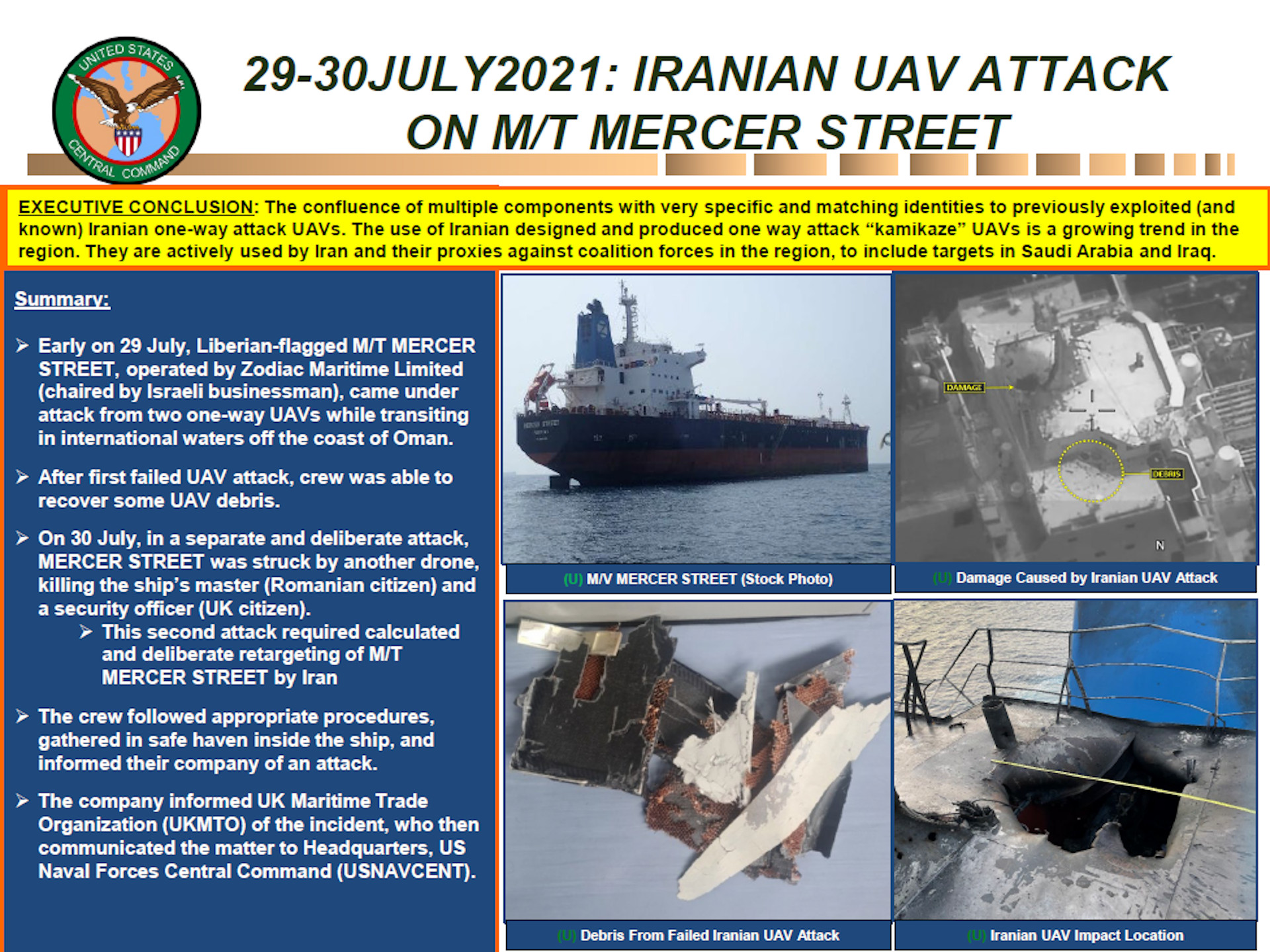
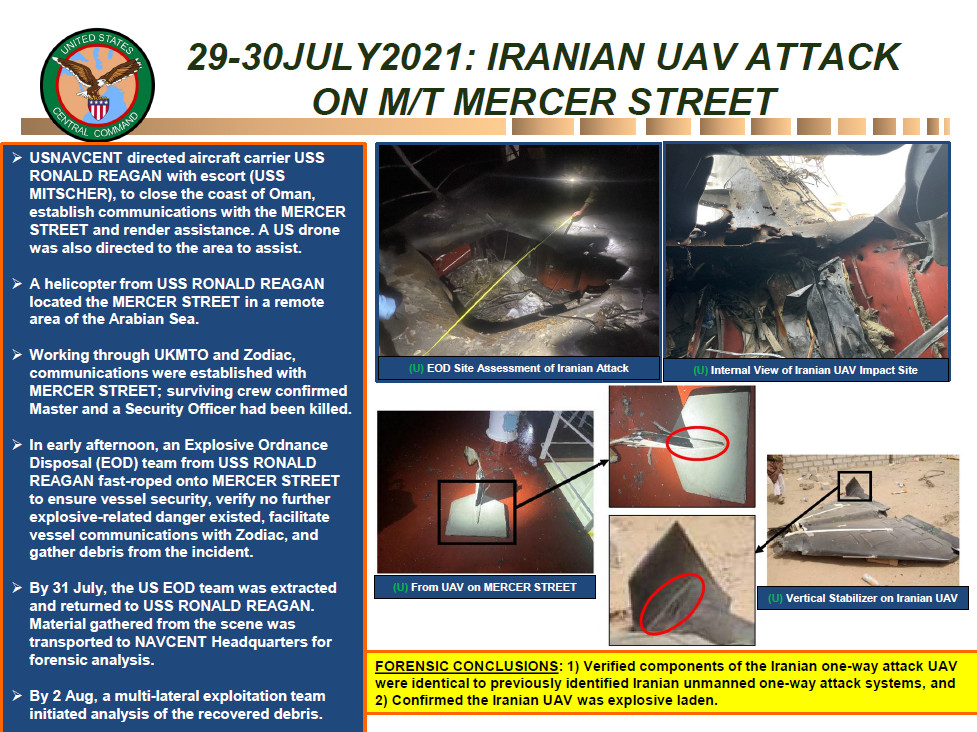
“An expert explosive investigative team from the [aircraft carrier] USS Ronald Reagan embarked the M/T to examine the evidence and interview the surviving crew members,” an official press release issued today, which accompanied a presentation detailing various findings so far, stated. The “Explosive Ordnance Disposal (EOD) team from USS RONALD REAGAN fast-roped onto MERCER STREET to ensure vessel security, verify no further explosive-related danger existed, facilitate vessel communications with Zodiac, and gather debris from the incident,” according to one of the presentation’s slides.
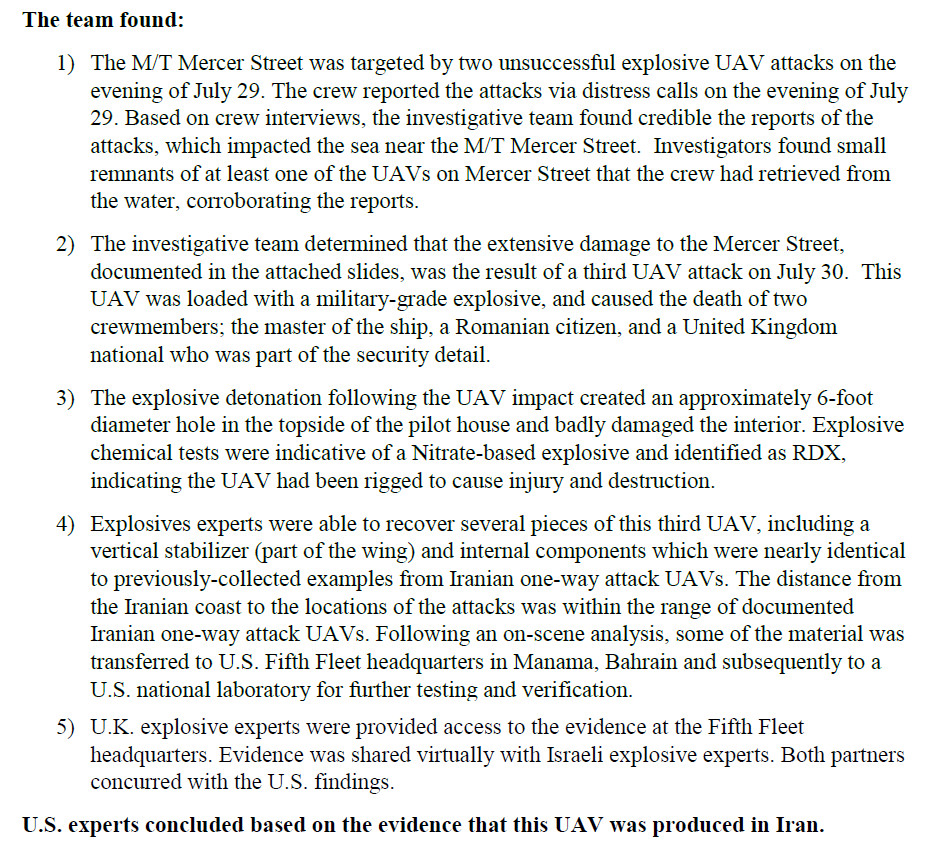
“The explosive detonation following the UAV impact created an approximately 6-foot diameter hole in the topside of the pilot house and badly damaged the interior,” the team subsequently concluded, according to CENTCOM. “Explosive chemical tests were indicative of a Nitrate-based explosive and identified as RDX, indicating the UAV had been rigged to cause injury and destruction.”
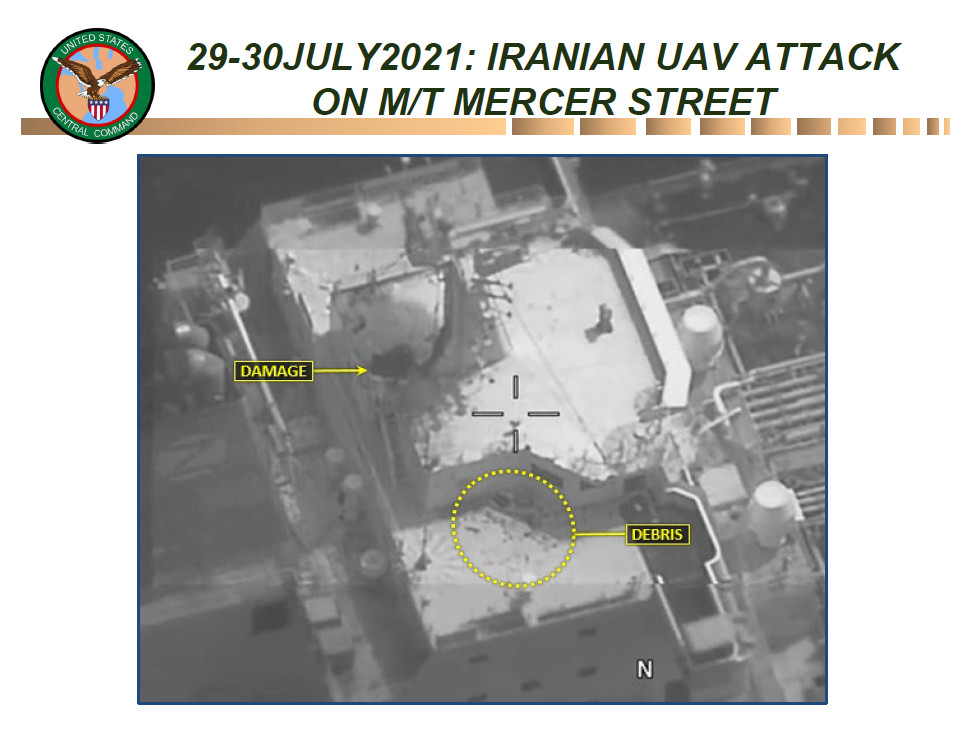

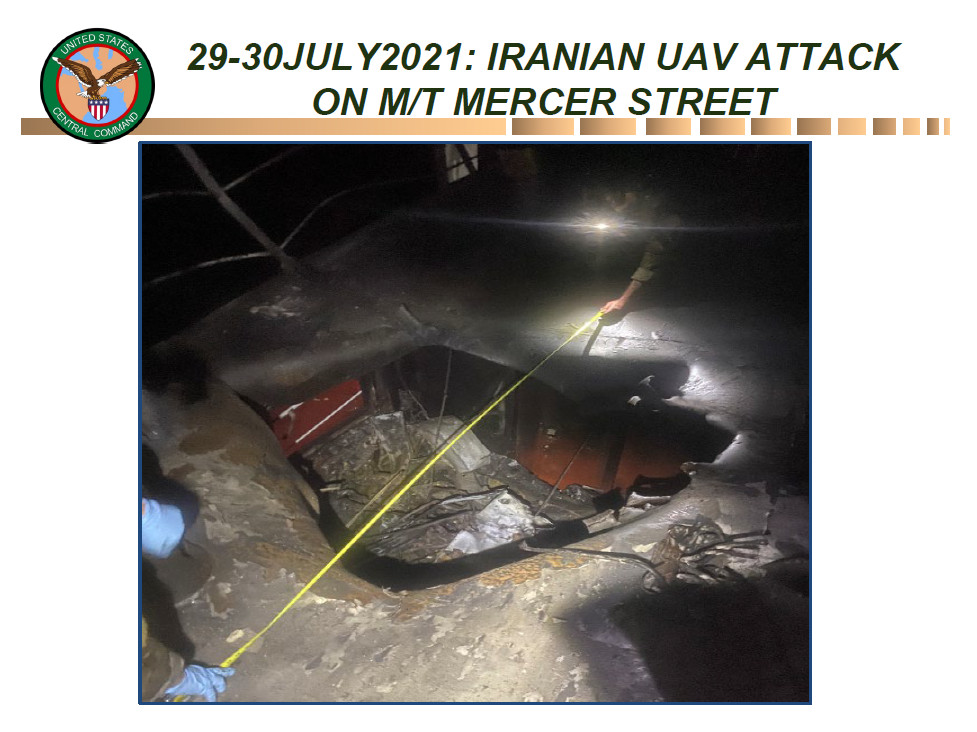
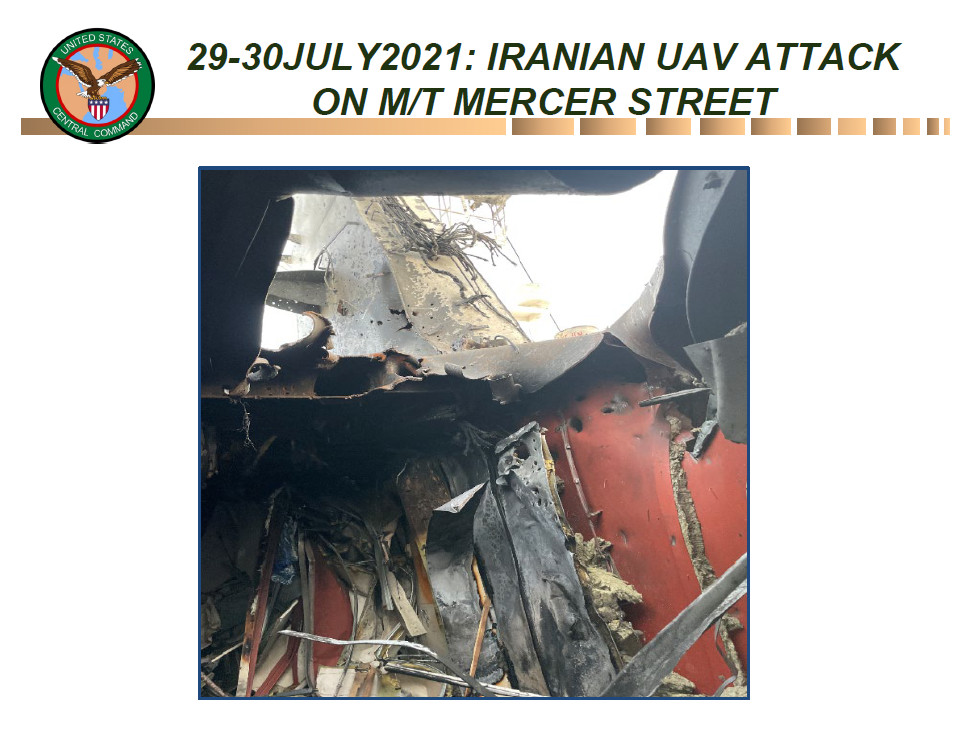
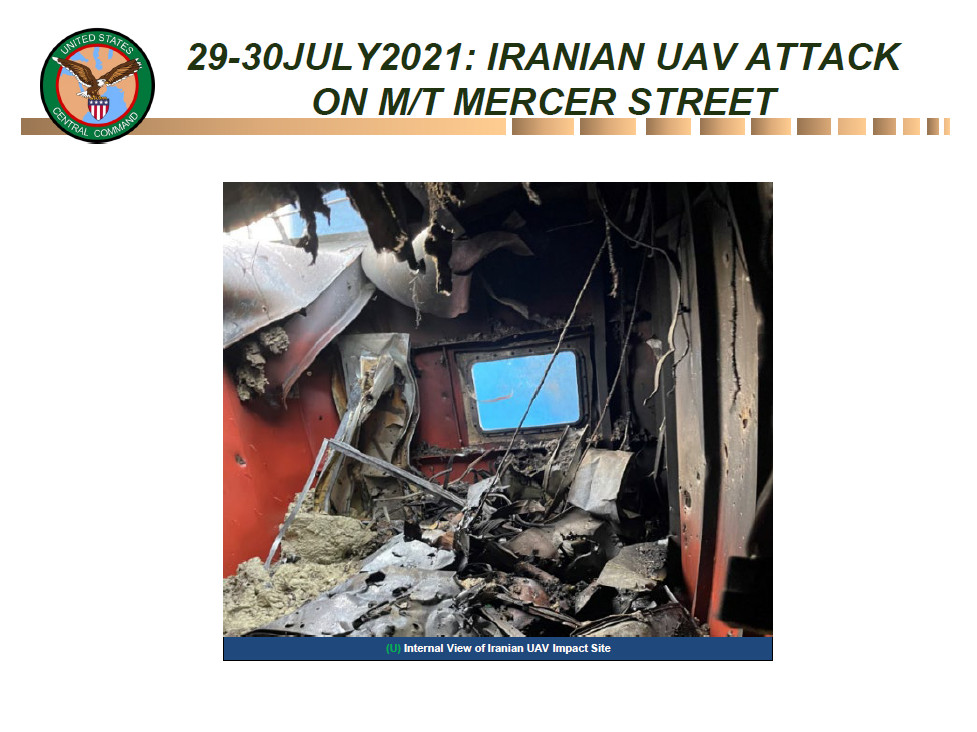
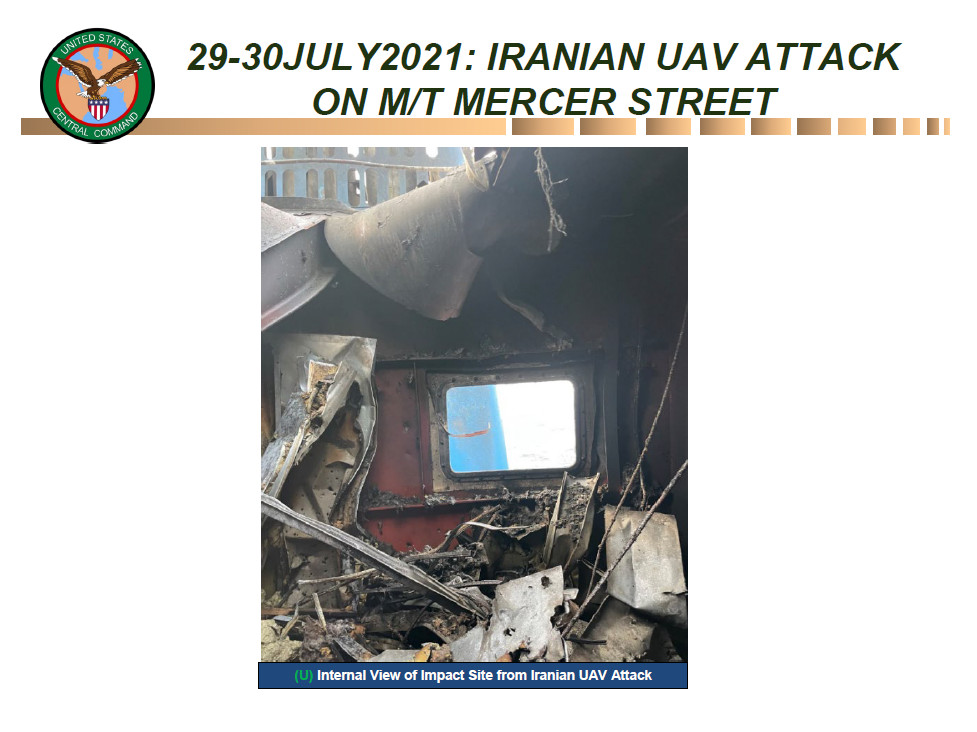
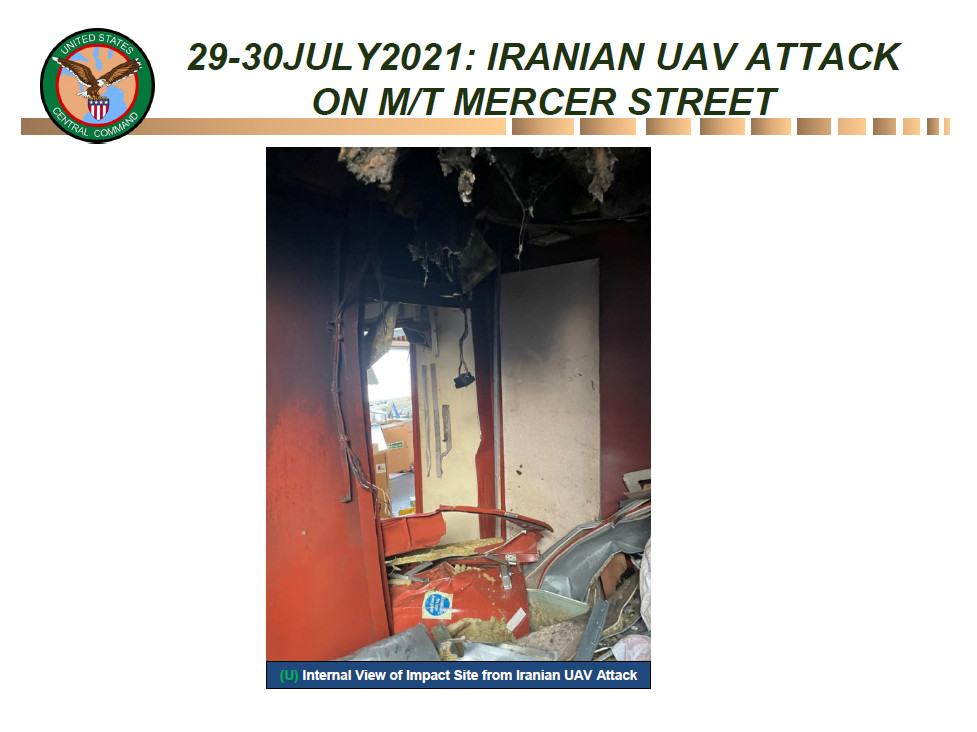
“Explosives experts were able to recover several pieces of this third UAV, including a vertical stabilizer (part of the wing) and internal components which were nearly identical to previously-collected examples from Iranian one-way attack UAVs,” the press release continues. “The distance from the Iranian coast to the locations of the attacks was within the range of documented Iranian one-way attack UAVs.”
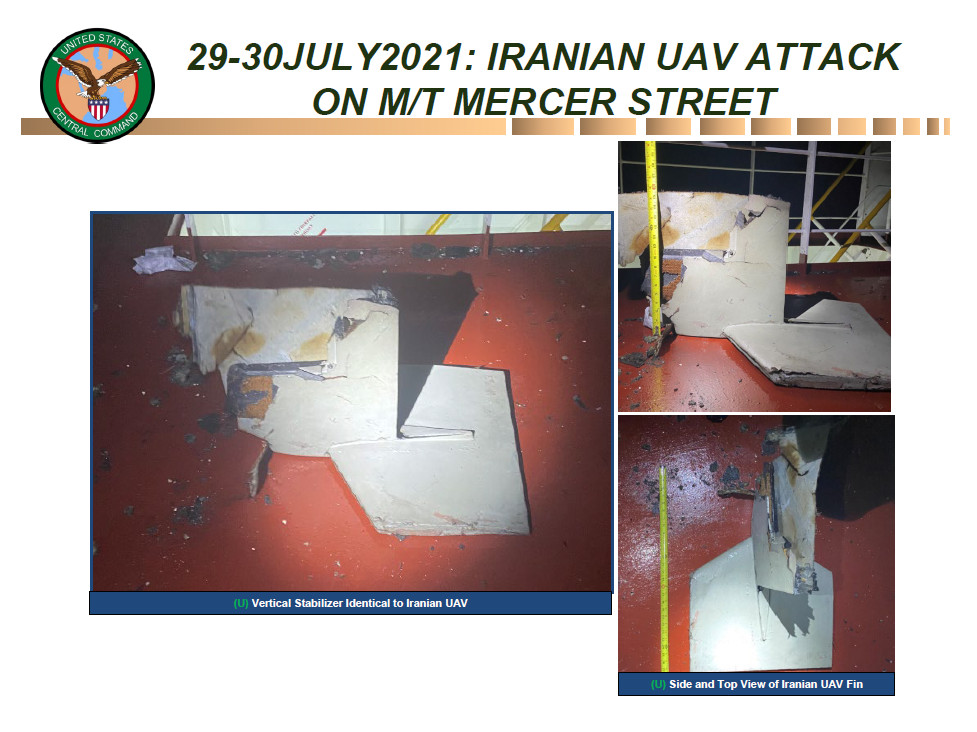
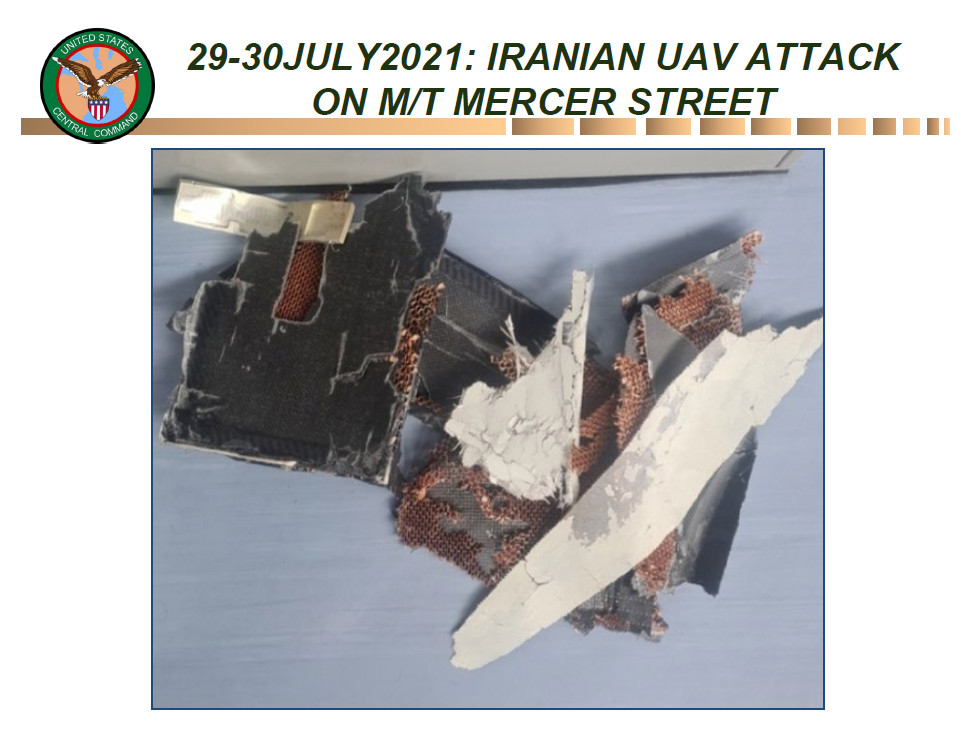
CENTCOM says that experts from the United Kingdom and Israel were also provided access to the evidence it had collected and that “both partners concurred with the U.S. findings.”
The U.S. investigative team said that it had “verified” that the debris leftover from the drone attacks on Mercer Street included components that were “identical to those identified on one of the Iranian designed and produced one-way attack ‘kamikaze’ UAV family.” In May 2021, Iran released video footage showing a demonstration of a larger example of one of these drones, which all have delta wing planforms, which is reportedly named the Shahed-136. The remains of one of these drones had been recovered in Yemen last year.
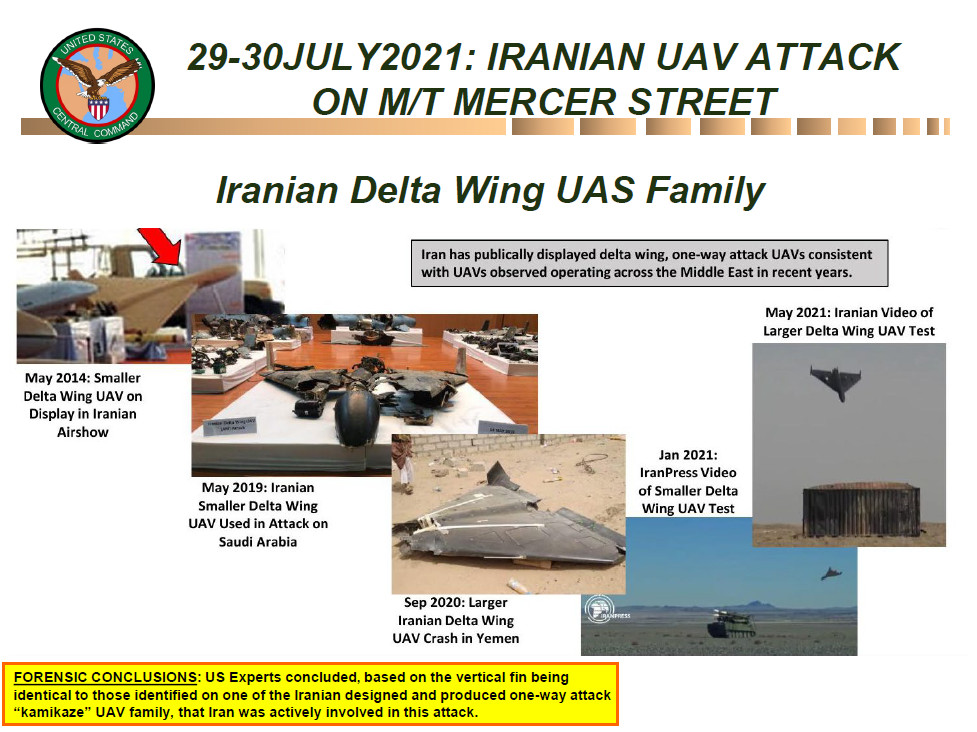
The Shahed-136 is an evolution of smaller Iranian delta wing unmanned aircraft designs, examples of which were used in the infamous drone and missile strikes on oil infrastructure in Saudi Arabia in 2019. Those strikes had already demonstrated the ability of the regime in Tehran and its proxies to use small drones to carry out attacks very far away from Iran itself.
All of this only provides more evidence that the attack on Mercer Street was part of an ongoing shadow war between Israel and Iran that has seen both countries target each others’ commercial and military vessels. A number of other ships with links to Israel have also suffered attacks in recent months. However, the third attack on Mercer Street was the first of these tit-for-tat incidents to cause any fatalities and could prompt an escalation in hostilities between those two countries, as well as significant reactions from the other parties involved, such as the United Kingdom and Romania.
“Israel is ready to attack Iran, yes,” Israeli Defense Minister Benny Gantz told the country’s Ynet news outlet yesterday in response to questions about the threats on multiple fronts posed by the regime in Tehran and its regional proxies. “We are at a point where we need to take military action against Iran. The world needs to take action against Iran now.”

“We are in very close contact in coordination with the United Kingdom, Israel, Romania, and other countries,” U.S. Secretary of State Antony Blinken had said on Aug. 2 in relation to the attacks on Mercer Street. “And there will be a collective response.”
The new details we have now about the attack on Mercer Street also simply highlight how real the threat posed by small drones to military forces and civilian entities alike is now and how it could become more so in the future. The Shahed-136 and its predecessors alone have now been linked to two significant attacks on foreign commercial targets. Smaller countries, as well as non-state actors, are increasingly employing suicide drones, in general, a concept first pioneered by Israel, to great effect in military operations and terrorist attacks. Iranian-backed proxies, with aid from Tehran, are among some of the more prolific users of these kinds of drones and their activities underscore the relatively low bar to entry when it comes to fielding these capabilities.
“Protecting U.S., Coalition and partner nation forces by countering the UAS [unmanned aircraft systems] threat remains a critical concern across the region,” Air Force Colonel Matt Dietz, the Director of Operations for Air Forces Central Command (AFCENT), said in a statement published just today regarding a counter-drone exercise his service conducted recently with its Saudi Arabian counterparts. “Our Saudi Arabian partners share that concern, and together we’re building on previous training to develop an effective, collaborative capability to protect our common interests.”
That exercise consisted of a “combined training operation to evaluate their ability to collaboratively track and destroy a simulated invading UAS within regional airspace” and involved F-15 fighter jets from the U.S. Air Force and the Royal Saudi Air Force intercepting a mock group of hostile drones over the Red Sea. At least one U.S. Air Force E-3 Sentry Airborne Warning and Control System (AWACS) also took part, helping to cue the fighters to the incoming threats and otherwise coordinate the operation.
The Royal Saudi Air Force has already accumulated a significant amount of experience in carrying out such missions as Iranian-backed Houthi rebels in Yemen routinely launch drone strikes into Saudi territory. Saudi F-15s, as well as Patriot surface-to-air missile batteries, are regularly employed to try to shoot them down.
As Colonel Dietz made clear, this recent exercise in Saudi Arabia reflects the broader threat that unmanned aircraft increasing pose in the region, as a whole. The Air Force conducted a similar drill in cooperation with the United Arab Emirates in June that also involved at least one E-3 Sentry, as well as an EC-130H Compass Call electronic warfare plane and an E-11A Battlefield Airborne Communications Node (BACN) aircraft. It is known that the Air Force has employed EC-130Hs to knock down drones in the past, with the platform reportedly achieving the first such kill against an unmanned aircraft that ISIS terrorists were operating in Iraq in 2016.
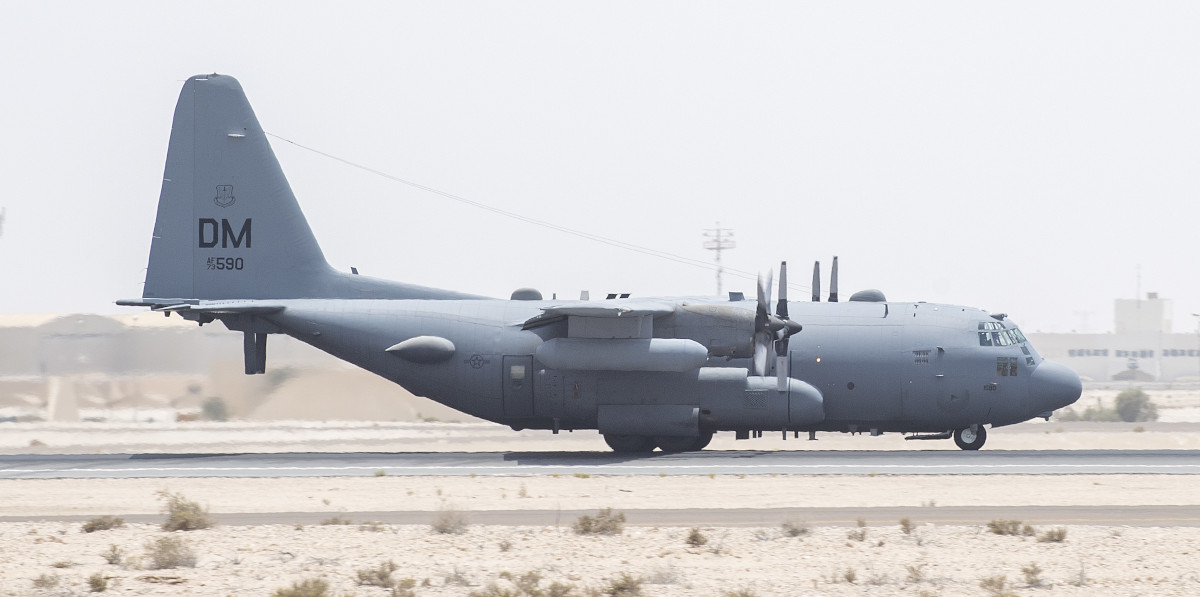
As the attacks on Mercer Street show, the threat of small drones isn’t limited to targets on land, either. The swarming of U.S. Navy destroyers off the coast of southern California by still-unidentified drones in 2019 makes clear that this is a potential issue for vessels around the world, not just in global hotspots, too.
“These small- and medium-sized UAS [unmanned aircraft systems] proliferating across the [area of operations] present a new and complex threat to our forces and those of our partners and allies,” U.S. Marine Corps General Frank McKenzie, CENTCOM’s commander, told members of Congress earlier this year, reiterating concerns he has been regularly highlighting since he assumed this position in 2019. “For the first time since the Korean War, we are operating without complete air superiority.”
The U.S. military, among others, has been working to field a wide array of counter-drone systems in recent years. In addition to various aerial capabilities, this includes an array of ground-based and ship-mounted systems, ranging from man-portable jammers to more traditional short-range air defense systems to new directed energy weapons, including both laser and high-powered microwave systems. The attack on Mercer Street points to how non-military entities may increasingly have to take similar steps to mitigate this threat, as well.
How the United States, Israel, and others now respond to the attacks on Mercer Street, especially now that the U.S. military has publicly disclosed this strong evidence of Iranian involvement, remains to be seen. Regardless, the incident is yet another alarm bell about how the threat of small drones is changing risk calculuses, even beyond traditional military operations.
Contact the author: joe@thedrive.com
